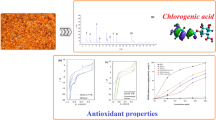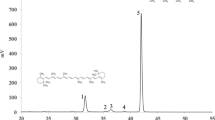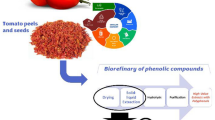Abstract
Deep eutectic solvents (DESs) have been explored as an alternative to hazardous solvents to extract phenolic compounds. The aim of this work was estimate the performance of choline chloride-based DESs regarding the extraction of phenolic compounds of tomato pomace and determination of their antioxidant activity. “Green” choline chloride-based DESs coupled with ultrasound-assisted extraction were performed to extract. The solvents were choline chloride:1,2-propanediol (1:2 v/w):water (10% w/w) and choline chloride:lactic acid (1:2 v/w):water (10% w/w).The phytochemical constituents of tomato pomace extracts were verified with a combination of high-performance liquid chromatography coupled to diode-array detection and tandem mass spectrometry (HPLC–DAD-MS). The total antioxidant activity of the extracts was assessed using phosphomolybdenum (PM) method. The redox behavior of tomato pomace extracts was evaluated by means of cyclic voltammetry. The DES-based tomato pomace extracts were used as the antioxidant agent to develop a natural cosmetic formulation (colloidal solutions). The ζ-potential, colloidal stability, and the antioxidant, antimicrobial, and antifungal activity were studied. The antioxidant activity of the cosmetic emulsions has been studied by means of cyclic voltammetry. The tomato pomace extracts contain significant quantity of phenolic acids and flavanols (26–37% of the total compounds). Chlorogenic acid was detected as the main phenolic compound in tomato pomace extracts (ranging from 37.23 to 52.33 μg/g). The total antioxidant power of the extracts varies in the range at 408 to 511.18 μg/g extract. Choline chloride-based DESs have low values of oxidation potentials. Zeta-potential of obtained colloidal solutions (cosmetic formulation) varies from − 0.0102 to − 0.0594 mV indicating the moderate stability of obtained cosmetic emulsions. The following ranking of antioxidants was obtained: cosmetic emulsions with extract obtained by choline chloride:lactic acid deep eutectic solvent > cosmetic emulsions with extract obtained by choline chloride:1,2-propanediol deep eutectic solvent. Antibacterial and antifungal activity of the cosmetic emulsions with DES extracts relative to Gram-positive (Bacillus subtilis), Gram-negative (Escherichia coli), and Candida albicans wound pathogens were studied. Thus the DESs could serve as solvents to produce a phenolic-rich tomato extract could be readily applicable to cosmetic formulations.









Similar content being viewed by others
Data Availability
Availability of data and material
References
Jablonsky M, Skulcova A, Malvis A, Sima J (2018) Extraction of value-added components from food industry based and agro forest biowastes by deep eutectic solvents. J Biotechnol 282:46–66. https://doi.org/10.1016/j.jbiotec.2018.06.349
Laufenberg G, Kunz B, Nystroem M (2003) Transformation of vegetable waste into value added products: (A) the upgrading concept; (B) practical implementations. Biores Technol 87(2):167–198. https://doi.org/10.1016/s0960-8524(02)00167-0
Rohm H, Brennan C, Turner C, Günther E, Campbell G (2015) Adding value to fruit processing waste: innovative ways to incorporate fibers from berry pomace in baked and extruded cereal-based foods—a SUSFOOD project. Foods 4(4):690–697. https://doi.org/10.3390/foods4040690
Vasyliev G, Vorobyova V, Zhuk T (2020) Raphanus sativus L. extract as a scale and corrosion inhibitor for mild steel in tap water. Journal of Chemistry 2020: 5089758, 9 pages https://doi.org/10.1155/2020/5089758
Vasyliev G, Vorobiova V (2019) Rape grist extract (Brassica napus) as a green corrosion inhibitor for water systems. Materials today.Prosseding 6(2):178–186.https://doi.org/10.1016/j.matpr.2018.10.092
Vorobyova V., Skiba M., Chygyrynets’ O (2019) A novel eco-friendly vapor phase corrosion inhibitor of mild steel. Pigment and Resin Technology 48(2):137–147 https://doi.org/10.23939/chcht12.03.410
Vorobyova V, Chygyrynets’ O, Skiba M, Trus I, Frolenkova S. (2018) Grape pomace extract as green vapor phase corrosion inhibitor. Ch&ChT 12(3):410–418. https://doi.org/10.1016/j.surfcoat.2009.10.054
Chyhyrynets OE, Fateev YF, Vorobiova VI, Skyba MI (2016) Study of the mechanism of action of the isopropanol extract of rapeseed oil cake on the atmospheric corrosion of copper. Mater Sci 51(5):644–651. https://doi.org/10.1007/s11003-016-9886-4
Vorobyova V, Skiba M (2021) Peach pomace extract as efficient sustainable inhibitor for carbon steel against chloride induced corrosion. Journal of Bio- and Tribo-Corrosion 7:11. https://doi.org/10.1007/s40735-020-00450-y
Vorobyova VI, Skiba MI, Shakun AS and Nahirniak SV (2019) Relationship between the inhibition and antioxidant properties of the plant and biomass wastes extracts – a review. Int. J. Corros. Scale Inhib 8 (2):150–178. https://doi.org/10.17675/2305-6894-2019-8-2-1
Wang T, Xu W-J, Wang S-X, Kou P, Wang P, Wang X-Q, Fu Y-J (2017) Integrated and sustainable separation of chlorogenic acid from blueberry leaves by deep eutectic solvents coupled with aqueous two-phase system. Food Bioprod Process 105:205–214
Cvjetko Bubalo M, Vidović S, Radojčić Redovniković I, Jokić S (2018) New perspective in extraction of plant biologically active compounds by green solvents. Food Bioprod Process 109:52–73
Ma Y, Li P, Willot J-PS, Zhang W, Ribitsch D, Choi YH, Wang Y (2019) Natural deep eutectic solvents as multifunctional media for the valorisation of agricultural wastes. Chemsuschem. https://doi.org/10.1002/cssc.201900043
Dai Y., vanSpronsen J., Witkamp G.-J., Verpoorte R., and Choi Y. H., (2013) Natural deep eutectic solvents as new potential media for green technology. AnalyticaChimicaActa 76661–68 https://doi.org/10.1016/j.aca.2012.12.019
Banjare MK, Behera K, Banjare RK, SahuR., Sharma S, Pandey S, and Ghosh KK, (2019) Interaction of ionic liquid with silver nanoparticles: potential application in induced structural changes of globular proteins. ACS Sustainable Chemistry & Engineering 7(13):11088–11100
Banjare MK, Behera K, Kurrey R, Banjare RK, Satnami ML, Pandey S, Ghosh KK (2018) Self-aggregation of bio-surfactants within ionic liquid 1-ethyl-3-methylimidazolium bromide: a comparative study and potential application in antidepressants drug aggregation. Spectrochim Acta Part A Mol Biomol Spectrosc 199:376–386. https://doi.org/10.1016/j.saa.2018.03.079
Bangia JK, Singh M, Om H, Behera K, Gulia M (2017) Physicochemical study of nanoemulsions of aqueous cellulose acetate propionate, cellulose acetate butyrate and tween 80 with castor, olive and linseed oils from temperature (293.15 to 313.15) K. J Mol Liq 225:758–766. https://doi.org/10.1016/j.molliq.2019.111043
Pal M, Behera K, Yadav A, Pandey S (2018) Modifying properties of aqueous micellar solutions by external additives: deep eutectic solvent versus its constituents. Chemistry Select 3(44):12652–12660. https://doi.org/10.1002/slct.201802169
Rai R, Kumar V, Pandey S (2014) Aggregation of a model porphyrin within poly(ethylene glycol) (PEG): effect of water, PEG molecular weight, ionic liquids, salts, and temperature. Phys Chem ChemPhys 16(16):7263–7273. https://doi.org/10.1039/C4CP00103F
Rai R, Pandey S (2014) Evidence of water-in-ionic liquid microemulsion formation by nonionic surfactant brij-35. Langmuir 30(34):10156–10160. https://doi.org/10.1021/la502174a
Ijaz N, Durrani RAIS, Bahadur S (2021) Formulation and characterization of Aloe vera gel and tomato powder containing cream. Acta EcologicaSinica. https://doi.org/10.1016/j.chnaes.2021.01.005
Opriş O, Soran ML, Lung I et al (2021) Optimization of extraction conditions of polyphenols, antioxidant capacity and sun protection factor from Prunusspinosa fruits. Application in sunscreen formulation J IRAN CHEM SOC. https://doi.org/10.1007/s13738-021-02217-9
da Silva MJF, Rodrigues AM, Vieira IRS, Neves GA, Menezes RR, Gonçalves EGR, Pires MCC (2020) Development and characterization of a babassu nut oil-based moisturizing cosmetic emulsion with a high sun protection factor. RSC Adv 10(44):26268–26276. https://doi.org/10.1039/D0RA00647E
Lu Z, Wang J, Gao R, Ye F, Zhao G (2019) Sustainable valorisation of tomato pomace: a comprehensive review. Trends Food Sci Technol 86:172–187. https://doi.org/10.1016/j.tifs.2019.02.020
Allison BJ, Simmons CW (2017) Valorization of tomato pomace by sequential lycopene extraction and anaerobic digestion. Biomass Bioenerg 105:331–341. https://doi.org/10.1016/j.biombioe.2017.07.019
Pinela J, Prieto MA, Carvalho AM, Barreiro MF, Oliveira MBPP, Barros L, Ferreira ICFR (2016) Microwave-assisted extraction of phenolic acids and flavonoids and production of antioxidant ingredients from tomato: a nutraceutical-oriented optimization study. Sep Purif Technol 164:114–124. https://doi.org/10.1016/j.seppur.2016.03.030
Calvo MM, Dado D, Santa-Maria G (2007) Influence of extraction with ethanol or ethyl acetate on the yield of lycopene, beta-carotene, phytoene and phytofluene from tomato peel powder. Eur Food Res Technol 224:567–571. https://doi.org/10.1007/s00217-006-0335-8
Silva YPA, Ferreira TAPC, Jiao G et al (2019) Sustainable approach for lycopene extraction from tomato processing by-product using hydrophobic eutectic solvents. J Food SciTechnol 56:1649–1654. https://doi.org/10.1007/s13197-019-03618-8
Nagarajan J, Pui Kay H, Krishnamurthy NP, Ramakrishnan NR, Aldawoud TMS, Galanakis CM, Wei OC (2020) Extraction of carotenoids from tomato pomace via water-induced hydrocolloidal complexation biomolecules 10(7):1019. https://doi.org/10.3390/biom10071019
Šojić BP, B, Tomović V, Kocić-Tanackov S, Đurović S, Zeković Z, and Škaljac S, (2020) Tomato pomace extract and organic peppermint essential oil as effective sodium nitrite replacement in cooked pork sausages. Food Chem 330:127202. https://doi.org/10.1016/j.foodchem.2020.127202
Rajha HN, Mhanna T, El Kantar S, El Khoury A, Louka N, Maroun GR (2019) Innovative process of polyphenols recovery from pomegranate peels by combining green deep eutectic solvents and a new infrared technology. LWT 11:138–146. https://doi.org/10.1016/j.lwt.2019.05.004
García AE, Rodríguez-Juan G-G, Rios JJ, Fernández-Bolaños J (2016) Extraction of phenolic compounds from virgin olive oil by deep eutectic solvents (DESs). Food Chem 197:554–561. https://doi.org/10.1016/j.foodchem.2015.10.131
Ming-Zhua G, Qia C., Li-Taob W, Yaoa M, Liana Y, Yan-Yana L, and Yu-Jiea F (2020) A green and integrated strategy for enhanced phenolic compounds extraction from mulberry (Morus alba L.) leaves by deep eutectic solvent.Microchemical Journal 154:104598 https://doi.org/10.1016/j.microc.2020.104598
Ozturk B, Parkinson C, Gonzalez-Miquel M (2018) Extraction of polyphenolic antioxidants from orange peel waste using deep eutectic solvents. Sep Purif Technol 206:1–13. https://doi.org/10.1016/j.seppur.2018.05.052
Baltacıoğlua H, Baltacıoğlua C, OkurI I, Tanrıvermişa A, Yalıça M (2021) Characterization by FTIR and HPLC and comparison with conventional solvent extraction. Vib Spectrosc 113:103204. https://doi.org/10.1016/j.vibspec.2020.103204
Sarno M, Iuliano M (2019) Highly active and stable Fe3O4/Au nanoparticles supporting lipase catalyst for biodiesel production from waste tomato. Appl Surf Sci 474:135–146. https://doi.org/10.1016/j.apsusc.2018.04.060
Grassino AN, Halambek J, Djaković S, RimacBrnčić S, Dent M, andZ. Grabarić, (2016) Utilization of tomato peel waste from canning factory as a potential source for pectin production and application as tin corrosion inhibitor". Food Hydrocolloids 52:265–274. https://doi.org/10.1016/j.foodhyd.2015.06.020
Silva YP, Ferreira TA, Celli GB, Brooks MS (2019) DES based solvent was used to extract lycopene from tomato pomace waste. Optimization of lycopene extraction from tomato processing waste using an eco-friendly ethyl lactate-ethyl acetate solvent: a green valorization approach Waste and Biomass Valorization 10(10):2851–2861
Bubalo MC, Vidović S, Redovniković IR, Jokić S (2018) New perspective in extraction of plant biologically active compounds by green solvents, Food Bioprod. Process 109:52–73. https://doi.org/10.1016/j.fbp.2018.03.001
Sibhatu HK, Jabasingh SA, Yimam A, Ahmed S (2020) Ferulic acid production from brewery spent grains, an agro-industrial waste. LWT 135:110009. https://doi.org/10.1016/j.lwt.2020.110009
Ralph N, Walid B, Agnès M, Jérôme B, Marchala L (2021) Production of oil in water emulsions in microchannels at high throughput: Evaluation of emulsions in view of cosmetic, nutraceutical or pharmaceutical applications. Chemical Engineering and Processing - Process Intensification 161:108301. https://doi.org/10.1016/j.cep.2021.108301
Vasyliev GS, Vorobyova VI, Linyucheva OV (2020) Evaluation of reducing ability and antioxidant activity of fruit pomace extracts by spectrophotometric and electrochemical methods. J Anal Methods Chem 2020:8869436. https://doi.org/10.1155/2020/8869436
Chandrasekar RK, Priyanka K, Sakhira Sreeprada K, Harshitha K, Haripriya B, Babu MN (2018) Formulation and stability evaluation of natural preservatives in polyherbal skin care cream. Int J Res Dev Pharm Life Sci 7(3):2999–3005
Dai Y, Witkamp GJ, Verpoorte R, Choi YH (2013) Natural deep eutectic solvents as a new extraction media for phenolic metabo-lites in CarthamustinctoriusL. Anal Chem 85(13):6272–6278. https://doi.org/10.1021/ac400432p
Roselló-Soto E, Martí-Quijal F, Cilla A, Munekata P, Lorenzo J, Remize F, Barba F (2019) Influence of temperature, solvent and pH on the selective extraction of phenolic compounds from tiger nuts by-products: triple-TOF-LC-MS-MS Characterization. Molecules 24(4):797. https://doi.org/10.3390/molecules24040797
Wojeicchowski PJ, Marques C, Igarashi-Mafra L, Coutinho JAP, Mafra MR (2020) Extraction of phenolic compounds from rosemary using choline chloride – based deep eutectic solvents. Sep Purif Technol. https://doi.org/10.1016/j.seppur.2020.117975
Ferreira A, Vecino X, Ferreira D, Cruz JM, Moldes AB, Rodrigues LR (2017) Novel cosmetic formulations containing a biosurfactant from Lactobacillus paracasei. Colloids Surf, B 155:522–529. https://doi.org/10.1016/j.colsurfb.2017.04.026
Li D, Zhao Y, Wang X, Tang H, Wu N, Wu F, Elfalleh W (2019) Effects of (+)-catechin on a rice bran protein oil-in-water emulsion: droplet size, zeta-potential, emulsifying properties, and rheological behavior. Food Hydrocolloids 98:105306. https://doi.org/10.1016/j.foodhyd.2019.105306
Dima, Cristian; Dima, Stefan (2020). Bioaccessibility study of calcium and vitamin D3 co-microencapsulated in water-in-oil-in-water double emulsions.Food Chemistry, 303(), 125416–. https://doi.org/10.1016/j.foodchem.2019.125416
Tian L, Yang K, Zhang S, Yi J, Zhu Z, Decker EA, Mc Clements DJ (2021) Impact of tea polyphenols on the stability of oil-in-water emulsions coated by whey proteins. Food Chem 343:128448. https://doi.org/10.1016/j.foodchem.2020.128448
Chu CC, Nyam KL (2020) Kenaf (Hibiscus cannabinus L.) seed oil: application as cosmetic product ingredients. Industrial Crops and Products 156:112871.https://doi.org/10.1016/j.indcrop.2020.112871
Runeman JO, Faergemann LB (2000) Experimental Candida albicans lesions in healthy humans: dependence on skin pH. Acta Derm Venereol 80(6):421–424. https://doi.org/10.1080/000155500300012819
Carranza A, Song K, Soltero-Martínez JFA, Wu Q, Pojman JA, Mota-Morales JD (2016) On the stability and chemorheology of a urea choline chloride deep-eutectic solvent as an internal phase in acrylic high internal phase emulsions. RSC Adv 6(85):81694–81702. https://doi.org/10.1039/C6RA18931H
Yan Yi SimKar Lin Nyam (2021) Application of Hibiscus cannabinus L. (kenaf) leaves extract as skin whitening and anti-aging agents in natural cosmetic prototype, Industrial Crops and Products 167:113491.https://doi.org/10.1016/j.indcrop.2021.113491
Fresneda M, Trujillo-Cayado LA, García MC, Alfaro-Rodriguez MC, Muñoz J (2020) Production of more sustainable emulsions formulated with eco-friendly materials. J Clean Prod 243:118661. https://doi.org/10.1016/j.jclepro.2019.118661
Nizioł-Łukaszewska Z, Wasilewski T, Bujak T, Gaweł-Bęben K, Osika P, &Czerwonka D (2018) Cornus mas L. extract as a multifunctional material for manufacturing cosmetic emulsions. Chinese Journal of Natural Medicines 16(4) 284–292. https://doi.org/10.1016/s1875-5364(18)30058-x
Ratz-Lyko A, Arct J, Pytkowska K (2011) Methods for evaluation of cosmetic antioxidant capacity. Skin Research and Technology 18(4):421–430. https://doi.org/10.1111/j.1600-0846.2011.00588.x
Chauhan L, Gupta S (2021) Creams: a review on classification, preparation methods, evaluation and its applications. JDDT 10(5-s):281–289. https://doi.org/10.22270/jddt.v10i5-s.4430
Abbasi-Parizad PDN, Adani F, Pepé ST, Pietro S, Scarafoni A, Iametti S, Scaglia B (2020) Antioxidant and anti-inflammatory activities of the crude extracts of raw and fermented tomato pomace and their correlations with aglycate-polyphenols by Parisa. Antioxidants 9(2):179. https://doi.org/10.3390/antiox9020179
Abbasi-Parizada P, Patriza DN, Scaglia B, Adani F (2021) Recovery of phenolic compounds from agro-industrial by-products: evaluating antiradical activities and immunomodulatory properties. Food Bioprod Process 127:338–348. https://doi.org/10.1016/j.fbp.2021.03.015
Azabou, S., Louati, I., Ben Taheur, F. et al. Towards sustainable management of tomato pomace through the recovery of valuable compounds and sequential production of low-cost biosorbent. Environ Sci Pollut Res 27, 39402–39412 (2020). https://doi.org/10.1007/s11356-020-09835-5
Khalaf H. H., Sharoba A. M., El Sadani R. A., Fawzia M. El Nashaby; Elshiemy S. M. (2014) Antioxidant properties of some extracts from gamma irradiated tomato (lycopersicon esculentum l.) pomace. J. Food and Dairy Sci., Mansoura Univ., Vol. 5 (4): 247 - 263, https://doi.org/10.21608/JFDS.2014.52768
Abbasi-Parizad P, De Nisi P, Scaglia B, Scarafoni A, Pilu S, Adani F (2021) Recovery of phenolic compounds from agro-industrial by-products: evaluating antiradical activities and immunomodulatory properties. Food Bioprod Process 127:338–348. https://doi.org/10.1016/j.fbp.2021.03.015
Funding
This work was supported by the Ministry of Education and Science of Ukraine [grant no. 2403, 2021].
Author information
Authors and Affiliations
Contributions
Viktoria Vorobyova: conceptualization, methodology, investigation, writing — original draft. Georgii Vasyliev: cyclic voltammetry analysis, writing — review and editing draft. Khrokalo Lyudmyla: microbiology analysis. Margarita Skiba: formal analysis.
Corresponding author
Ethics declarations
Ethics approval
Authors agree with ethical standards.
Consent to participate
Authors agree with to participate as author of the article.
Consent for publication
Authors agree publication of the article.
Conflict of interest
The authors declare no competing interests.
Additional information
Publisher’s note
Springer Nature remains neutral with regard to jurisdictional claims in published maps and institutional affiliations.
Highlights
• HPLC–DAD-MS analysis confirmed the abundance of phenolic compounds in tomato pomace extracts obtained using DES.
• Antioxidant activity determined by phosphomolybdenum method shows a direct relationship with the used of type of DES for extraction.
• Cosmetic emulsion with the addition of extracts obtained by DES has satisfactory physicochemical characteristics.
• The ability of tomato pomace extracts to influence the physicochemical and antioxidant properties of cosmetic emulsion samples was established.
Supplementary Information
Below is the link to the electronic supplementary material.
Rights and permissions
About this article
Cite this article
Vasyliev, G., Lyudmyla, K., Hladun, K. et al. Valorization of tomato pomace: extraction of value-added components by deep eutectic solvents and their application in the formulation of cosmetic emulsions. Biomass Conv. Bioref. 12 (Suppl 1), 95–111 (2022). https://doi.org/10.1007/s13399-022-02337-z
Received:
Revised:
Accepted:
Published:
Issue Date:
DOI: https://doi.org/10.1007/s13399-022-02337-z




